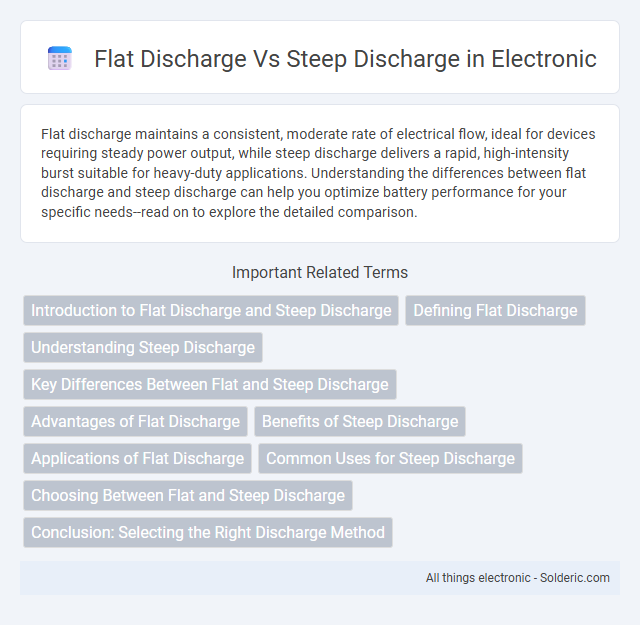Flat discharge maintains a consistent, moderate rate of electrical flow, ideal for devices requiring steady power output, while steep discharge delivers a rapid, high-intensity burst suitable for heavy-duty applications. Understanding the differences between flat discharge and steep discharge can help you optimize battery performance for your specific needs--read on to explore the detailed comparison.
Comparison Table
| Feature | Flat Discharge | Steep Discharge |
|---|---|---|
| Definition | Gradual reduction of voltage over time | Rapid voltage drop in a short time |
| Voltage Stability | Maintains relatively consistent voltage | Voltage drops sharply, less stable |
| Battery Life Impact | Extends battery cycle life | May reduce battery lifespan |
| Energy Efficiency | Higher energy utilization | Lower overall energy efficiency |
| Typical Applications | Consumer electronics, UPS systems | High-drain devices, emergency power |
| Discharge Curve Shape | Flattened, gradual slope | Steep, rapid decline |
Introduction to Flat Discharge and Steep Discharge
Flat discharge refers to a gradual release of electrical energy characterized by a slow decline in voltage over time, often seen in capacitors and batteries with stable output. Steep discharge involves a rapid drop in voltage, indicating a quick energy release typically observed in devices requiring sudden power bursts or in batteries under heavy load. Understanding the differences between flat and steep discharge is crucial for optimizing battery performance and longevity in various electronic applications.
Defining Flat Discharge
Flat discharge refers to a battery's electrical output characterized by a gradual and consistent voltage decline throughout its usage cycle, providing a stable power supply over time. This discharge pattern contrasts with steep discharge, where voltage drops rapidly after initial use, affecting device performance and runtime predictability. Understanding flat discharge behavior is crucial for applications requiring reliable energy delivery and extended battery life.
Understanding Steep Discharge
Steep discharge refers to a rapid decline in river or stream flow following a precipitation event, characterized by a sharp and quick drop in water levels. This type of discharge is typically associated with urbanized or impervious surfaces where runoff is swift, leading to flash floods and reduced infiltration. Understanding steep discharge is crucial for designing effective flood management systems and improving watershed resilience.
Key Differences Between Flat and Steep Discharge
Flat discharge features a gradual decline in the output voltage or current over time, maintaining a more consistent power supply, whereas steep discharge exhibits a rapid drop, leading to a quicker depletion of the energy source. This difference significantly impacts battery lifespan and device performance, as flat discharge is preferred for applications requiring steady power output. Steep discharge is commonly associated with high-drain devices that demand quick bursts of energy but can reduce overall battery efficiency and longevity.
Advantages of Flat Discharge
Flat discharge curves provide a more consistent voltage output over time, ensuring stable performance for sensitive electronic devices. This reliability extends battery life by preventing sudden drops in power, which can protect your equipment from unexpected shutdowns. Choosing flat discharge batteries enhances overall efficiency and user experience in applications requiring steady energy delivery.
Benefits of Steep Discharge
Steep discharge batteries offer rapid energy release, making them ideal for applications requiring high power output in short durations, such as power tools or electric vehicles. Their ability to deliver consistent voltage under heavy loads improves performance and reliability, ensuring your devices run efficiently without sudden drops in power. This fast discharge characteristic also enables quicker recharge cycles, enhancing overall battery lifespan and operational uptime.
Applications of Flat Discharge
Flat discharge curves are ideal for applications requiring consistent voltage output over time, such as in LED lighting, medical devices, and emergency backup systems. These batteries provide stable performance, ensuring your equipment operates reliably without sudden drops in power. Their ability to maintain voltage near nominal levels enhances device lifespan and user experience in critical, continuous-use scenarios.
Common Uses for Steep Discharge
Steep discharge is commonly used in applications requiring rapid power delivery and high current bursts, such as in electric vehicles, power tools, and emergency backup systems. Its ability to provide quick energy release makes it ideal for devices that demand intense but short-term power surges. Your choice of steep discharge batteries ensures efficient performance in high-drain environments where speed and power density are critical.
Choosing Between Flat and Steep Discharge
Choosing between flat discharge and steep discharge depends on the specific battery application and performance requirements. Flat discharge curves provide consistent voltage output over time, ideal for devices needing stable power, while steep discharge curves indicate rapid voltage drop suited for applications requiring high initial power but shorter runtime. Evaluating device power demands, runtime expectations, and battery chemistry ensures optimal selection between flat and steep discharge profiles.
Conclusion: Selecting the Right Discharge Method
Choosing between flat discharge and steep discharge depends on the specific application and desired performance outcomes. Flat discharge offers a gradual decline in power, ideal for applications requiring consistent energy output over time. Steep discharge suits scenarios needing rapid power delivery but short operational duration, making method selection critical for optimizing battery efficiency and lifespan.
Flat discharge vs Steep discharge Infographic

 solderic.com
solderic.com